- Home
- About
- Map
- Trips
- Bringing Boat West
- Migration West
- Solo Motorcycle Ride
- Final Family XC Trip
- Colorado Rockies
- Graduates' XC Trip
- Yosemite & Nevada
- Colorado & Utah
- Best of Utah
- Southern Loop
- Pacific Northwest
- Northern Loop
- Los Angeles to NYC
- East Coast Trips
- Martha's Vineyard
- 1 Week in Quebec
- Southeast Coast
- NH Backpacking
- Martha's Vineyard
- Canadian Maritimes
- Ocracoke Island
- Edisto Island
- First Landing '02
- Hunting Island '02
- Stowe in Winter
- Hunting Island '01
- Lake Placid
- Chesapeake
- Provincetown
- Hunting Island '00
- Acadia in Winter
- Boston Suburbs
- Niagara Falls
- First Landing '99
- Cape Hatteras
- West Coast Trips
- Burning Man
- Utah Off-Roading
- Maui
- Mojave 4WD Course
- Colorado River Rafting
- Bishop & Death Valley
- Kauai
- Yosemite Fall
- Utah Off-Road
- Lost Coast
- Yosemite Valley
- Arizona and New Mexico
- Pescadero & Capitola
- Bishop & Death Valley
- San Diego, Anza Borrego, Joshua Tree
- Carmel
- Death Valley in Fall
- Yosemite in the Fall
- Pacific Northwest
- Utah Off-Roading
- Southern CA Deserts
- Yosemite & Covid
- Lake Powell Covid
- Eastern Sierra & Covid
- Bishop & Death Valley
- Central & SE Oregon
- Mojave Road
- Eastern Sierra
- Trinity Alps
- Tuolumne Meadows
- Lake Powell Boating
- Eastern Sierra
- Yosemite Winter
- Hawaii
- 4WD Eastern Sierra
- 4WD Death Valley +
- Southern CA Deserts
- Christmas in Tahoe
- Yosemite & Pinnacles
- Totality
- Yosemite & Sierra
- Yosemite Christmas
- Yosemite, San Diego
- Yosemite & North CA
- Seattle to Sierra
- Southwest Deserts
- Yosemite & Sierra
- Pacific Northwest
- Yosemite & South CA
- Pacific Northwest
- Northern California
- Southern Alaska
- Vancouver Island
- International Trips
- Index
- Tips
- Books
- Photos/Videos
- Search
- Contact
Carmel and Side Trips , CA
Monday, December 13, 2021 - 11:15am by Lolo
180 miles and 3.25 hours from our last stop - 3 night stay
Travelogue
Day 1 - Drive to Monterey Peninsula, Pacific Grove Monarch Butterfly Sanctuary, and Point Lobos Perimeter Hike
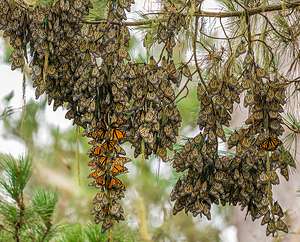 Cluster of monarch butterflies on eucalyptus branchI had done my homework and pretty much had a list of sights and activities to cover over our three-day visit. Herb always gets a little anxious when I pull out a few printed pages of a proposed itinerary I put together.
Cluster of monarch butterflies on eucalyptus branchI had done my homework and pretty much had a list of sights and activities to cover over our three-day visit. Herb always gets a little anxious when I pull out a few printed pages of a proposed itinerary I put together.
Since I had two events scheduled for the day, I suggested we get an early start so that we could get to the Pacific Grove Butterfly Sanctuary in time for their usual wake up at noon. They like to sleep in until it gets warm (usually at least 55 degrees).
Not wanting to view butterflies on an empty stomach, we stopped at the Alta Bakery and Cafe in Monterey, which we had seen as a recommendation on a YouTube video we had watched about Monterey. We actually find YouTube to be a useful resource for interesting places, good restaurants, etc. for any destination you can think of.
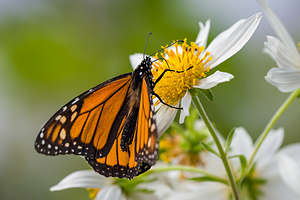 Brave little monarch leaves the clusterWe had tried once before to visit a Monarch Butterfly Grove when we were in Pismo Beach last March, only to find that all but a few had already flown away. Apparently Monarch Butterflies hang out, or more correctly “overwinter,” on the California Coast only between the months of October and February, with the best time to see the greatest numbers being mid-November to mid-December. Perfect.
Brave little monarch leaves the clusterWe had tried once before to visit a Monarch Butterfly Grove when we were in Pismo Beach last March, only to find that all but a few had already flown away. Apparently Monarch Butterflies hang out, or more correctly “overwinter,” on the California Coast only between the months of October and February, with the best time to see the greatest numbers being mid-November to mid-December. Perfect.
We got to the sanctuary around noon as planned to time with their active part of the day. There were probably already about 50 people or so, with tripods and long lenses aimed at the grove of eucalyptus trees along the paved path.
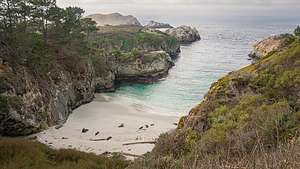 China Cove - Point Lobos Perimeter TrailFor the first 5 minutes, there wasn’t a butterfly to be seen. We got so excited when a single one landed in a flowering bush. Now Herb and I knew absolutely nothing about monarch butterfly behavior, so we just figured there were none to be seen.
China Cove - Point Lobos Perimeter TrailFor the first 5 minutes, there wasn’t a butterfly to be seen. We got so excited when a single one landed in a flowering bush. Now Herb and I knew absolutely nothing about monarch butterfly behavior, so we just figured there were none to be seen.
Fortunately, we overheard someone, who was pointing up towards the top of a eucalyptus tree, explain to their less-learned companion that what looked like a clump of dead leaves hanging from a branch was actually a cluster of butterflies huddled together for warmth. We learned that as many as tens of thousands of them can cluster on a single tree.
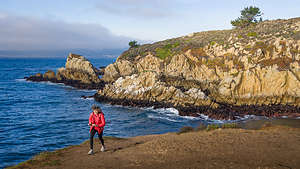 Along the Point Lobos Perimeter TrailGradually a few of them braved the cold and fluttered around the grove. We looked at our phones and it was 54 degrees. Come on sun. Just one more degree.
Along the Point Lobos Perimeter TrailGradually a few of them braved the cold and fluttered around the grove. We looked at our phones and it was 54 degrees. Come on sun. Just one more degree.
Herb joined the line of tripods and pointed his big lens up at one of the clusters. You couldn’t see much happening with the bare eye, but through the telephoto lens you could see layers and layers of butterfly wings, most of them brown (the one that were still closed), but a scattering of their characteristic bright orange on those getting ready for flight. It was quite beautiful.
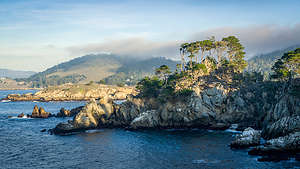 Along the Point Lobos Perimeter TrailI checked the hourly forecast and saw that it wasn’t going to get much warmer today, so we decided to leave for our second activity of the day - a hike around the Point Lobos State Natural Reserve, located just 4 miles south of Carmel-by-the-Sea.
Along the Point Lobos Perimeter TrailI checked the hourly forecast and saw that it wasn’t going to get much warmer today, so we decided to leave for our second activity of the day - a hike around the Point Lobos State Natural Reserve, located just 4 miles south of Carmel-by-the-Sea.
Point Lobos is short for Punta de los Lobos Marinos, which means Point of the Sea Wolves, referring to the sea lions you can find resting on its rocky points and nearby islands.
The reserve contains 550-acres of dramatic rocky coastline, coves, and rolling meadows. The offshore area forms one of the richest underwater habitats in the world, with seals, sea lions, sea otters and migrating gray whales from December to May.
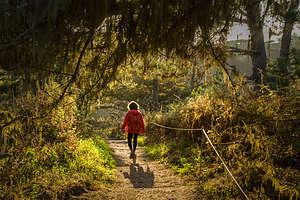 Along the Point Lobos Perimeter TrailToday our plan was to hike the 6-mile loop trail around its entirety, ending at Weston Beach for sunset. We paid our $9 at the gate ($1 discount for being old) and found parking near Sea Lion Point. We were lucky to catch the last spot that someone was just pulling out of.
Along the Point Lobos Perimeter TrailToday our plan was to hike the 6-mile loop trail around its entirety, ending at Weston Beach for sunset. We paid our $9 at the gate ($1 discount for being old) and found parking near Sea Lion Point. We were lucky to catch the last spot that someone was just pulling out of.
From there we set off in a counter-clockwise direction along the South Shore Trail, which went along the beautiful rocky coast.
We took a side loop along the Sand Hill Trail which led us out to a rocky point on the south side of Sea Lion Cove called Puna de los Lobos Marinos. From here we looked down at the churning waves known as the Devil’s Cauldron.
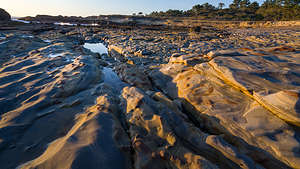 Weston Beach - Point LobosBack on the South Shore Trail, we reached Weston Beach in just under a mile. This was my planned place to spend the sunset, so I will hold off on describing it until later.
Weston Beach - Point LobosBack on the South Shore Trail, we reached Weston Beach in just under a mile. This was my planned place to spend the sunset, so I will hold off on describing it until later.
At 1.3 miles we arrived at Hidden Beach, a small cove with a gray pebbled beach. The mouth of the cove was very narrow with rocks encroaching on both sides. It looked very inviting, but we didn’t see a way down, so we continued on along the South Shore Trail.
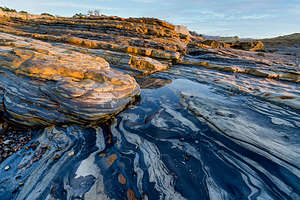 Weston Beach - Point LobosAt 1.5 miles, we came to a viewpoint that looked down on lovely China Cove, a sandy beach famous for its emerald-colored water. During the spring, this beach becomes home to harbor seals, nursing their newborn pups. We were a bit early for that, but we did see a handful of harbor seals relaxing on the beach, enjoying their free time before the arrival of their pups.
Weston Beach - Point LobosAt 1.5 miles, we came to a viewpoint that looked down on lovely China Cove, a sandy beach famous for its emerald-colored water. During the spring, this beach becomes home to harbor seals, nursing their newborn pups. We were a bit early for that, but we did see a handful of harbor seals relaxing on the beach, enjoying their free time before the arrival of their pups.
After another 0.1 mile we came to the end of the South Shore Trail, and the junction of the Bird Island Loop Trail to the right, and the inland South Plateau Trail to the left, which was part of the loop.
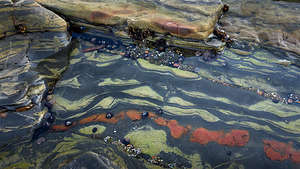 Weston Beach - Point LobosWe decided to take the short loop on the Bird Island Trail, where we passed between Monterey pine woods and the ocean. At the end, we were treated to another perspective of China Cove, as well as views down onto the larger, white-sand Gibson Beach. Gibson Beach is accessible via a staircase, but China Beach has been closed off since 2015.
Weston Beach - Point LobosWe decided to take the short loop on the Bird Island Trail, where we passed between Monterey pine woods and the ocean. At the end, we were treated to another perspective of China Cove, as well as views down onto the larger, white-sand Gibson Beach. Gibson Beach is accessible via a staircase, but China Beach has been closed off since 2015.
The sea pounds the cliffs along this section, enlarging the cracks and faults in the granite cliffs, creating caves, which slowly become arches, and eventually isolated rock croppings such as Bird Island. Spring and summer is definitely the best time to do this hike, because that’s when the harbor seals are pupping on China Cove Beach, and a large seabird colony of cormorants, Western gull, and black-crowned night herons take over Bird Island.
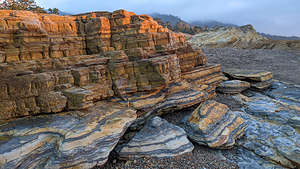 Weston Beach - Point LobosBack at the junction, we hiked northward along the South Plateau Trail through a lovely pine forest for about a mile, before arriving at Whale Cove. Rather than turn left to complete our loop, we decided to turn right and take the 1.2-mile side trip to Granite and Coal Chute Points.
Weston Beach - Point LobosBack at the junction, we hiked northward along the South Plateau Trail through a lovely pine forest for about a mile, before arriving at Whale Cove. Rather than turn left to complete our loop, we decided to turn right and take the 1.2-mile side trip to Granite and Coal Chute Points.
The Granite Point Trail followed a bluff above Whalers Cove with beautiful rocky outcrops jutting out to the sea. From the top of the hill at Granite Point there are great views of Carmel to the north.
On the way back to the main trail, we took the short Coal Chute Point loop, which got its name from the fact that it was the place where over 100 years ago, coal was loaded onto ships in Whalers Cove.
 Weston Beach Sunset - Point LobosFrom the end of the Granite Point side trip, we took the North Shore Trail back to our car. It was already 4:00 and very near to sunset, so we drove our car immediately over to Weston Beach. Our only regret was not having time to do the Cypress Grove Trail.
Weston Beach Sunset - Point LobosFrom the end of the Granite Point side trip, we took the North Shore Trail back to our car. It was already 4:00 and very near to sunset, so we drove our car immediately over to Weston Beach. Our only regret was not having time to do the Cypress Grove Trail.
Weston Beach is named for Edward Weston, the famous early to mid-20th century photographer, best known for his beautiful landscapes. He was a friend of Ansel Adams and with him, one of the founders of the f/64 club, a group of 11 San Francisco Bay Area-based photographers that shared a common photographic style, based on precisely exposed, sharply detailed, un-manipulated images of natural forms.
Ed Weston lived (and died) in Carmel and spent much time photographing this beach. While not as dramatically beautiful as sandy, emerald-green China Cove, it has lots of texture and plenty of opportunities for the sharply detailed images of natural forms that Edward Weston loved. There is no sand on this beach, but rather very unique rock textures that provide for very interesting foregrounds. It is also known for its tide pools.
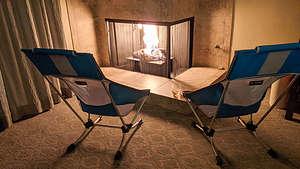 Our cozy fireplace at the Carmel Bay View InnWe spent the rest of the remaining daylight scampering around its rocks looking for interesting compositions.
Our cozy fireplace at the Carmel Bay View InnWe spent the rest of the remaining daylight scampering around its rocks looking for interesting compositions.
It had been a very long day, so we were very happy when we checked into our room at the Carmel Bay View Inn to find that it was even cozier than I expected. There was a beautiful gas fireplace in the corner of the room, in front of which we set up our camping chairs, and sipped a glass of well-deserved wine. Not wanting to move from the fireplace, we decided to eat the salads I had brought along rather than venturing out to a restaurant.
It was perfect!
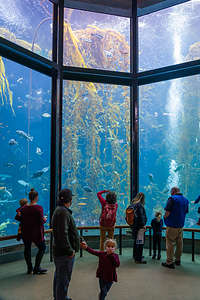 Monterey Bay Aquarium - Kelp Forest
Monterey Bay Aquarium - Kelp Forest
Day 2 - Monterey Aquarium, Fisherman’s Wharf and Cannery Row, 17-Mile Drive
Today was going to theoretically be the worst weather day of our mini-vacation, so we decided to go to the Monterey Aquarium, which we hadn’t been to in 25 years.
Because of Covid, tickets have to be purchased in advance and you have to be vaccinated. Yay! I always feel so much better knowing that those around me are responsible and less likely to spread any infected particles on me - or the fish!
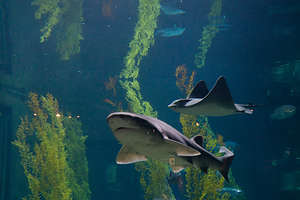 Kelp Forest residentsWe purchased tickets for 10:00 am, when doors opened, because we felt that would have the least crowds, because later times would have overlap from previous time slots.
Kelp Forest residentsWe purchased tickets for 10:00 am, when doors opened, because we felt that would have the least crowds, because later times would have overlap from previous time slots.
The first exhibit we visited was the Kelp forest where there was a 28-foot high tank (one of the tallest aquarium tanks in the world). In the actual ocean, they can tower up to 175 feet over the ocean floor. The habitat is called a kelp forest because they grow in dense groupings much like a land forest.
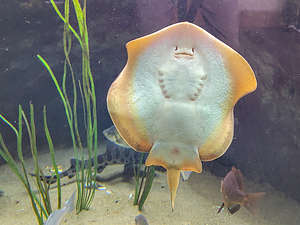 Friendly flounderKelp are brown algae that live in cool, relatively shallow waters all along the west coast of North America. In fact, it is what you would find on the Monterey Bay floor just outside the aquarium.
Friendly flounderKelp are brown algae that live in cool, relatively shallow waters all along the west coast of North America. In fact, it is what you would find on the Monterey Bay floor just outside the aquarium.
I never thought of kelp being beautiful, but I was mesmerized watching them swaying rhythmically in the tank, with fish weaving in and out of them, at all levels - some swimming in the canopy, while others lived on the fronds, and still others at the base of the frond.
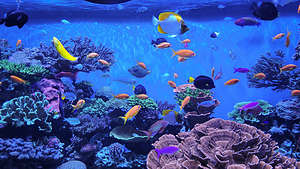 Wish I had this fish tankKelp forests provide food and shelter for a diverse community of plants and animals. Some of my favorites include the leopard shark, the bright orange garibaldi, the giant sea bass and California sheephead. There were also several volunteer scuba divers working in the tank.
Wish I had this fish tankKelp forests provide food and shelter for a diverse community of plants and animals. Some of my favorites include the leopard shark, the bright orange garibaldi, the giant sea bass and California sheephead. There were also several volunteer scuba divers working in the tank.
Our next stop was the touch pools, where you get to roll up your sleeves and pet bat rays. They are really cool and swim by flapping a pair of batlike wings, which are actually their pectoral fins.
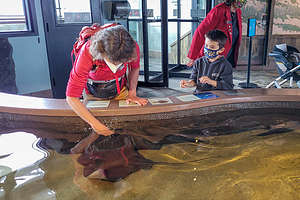 Lolo playing with the Bat RaysAfter being assured that they were harmless (I think the venomous spine in its tail has been removed), I plunged my arm almost up to my shoulder to reach and touch one. It surprisingly felt like velvet. It didn’t hang around long, as I am sure that it got pretty sick of arms reaching out at it all day.
Lolo playing with the Bat RaysAfter being assured that they were harmless (I think the venomous spine in its tail has been removed), I plunged my arm almost up to my shoulder to reach and touch one. It surprisingly felt like velvet. It didn’t hang around long, as I am sure that it got pretty sick of arms reaching out at it all day.
Next we went to the Jellyfish exhibit, where you could literally stand mesmerized for an hour in front of a beautifully-lit tank, watching orange sea nettles drift up and down like bubbles in a lava lamp. Actually, they propel themselves by contracting and relaxing a ring of muscles around its bell. The muscles open and close the bell, drawing in water and then forcing it out again to push the jellyfish forwards. It’s like a beautiful ballet.
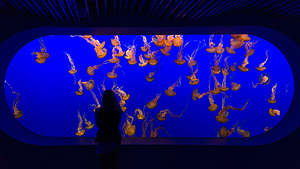 Jellyfish Tank - orange sea nettlesAlthough there are a great many different kinds of jellyfish, they all have gelatinous bodies and live in the water column. They are made up of more than 95% water and can range in size from miniscule to enormous. They have no bones, brains, teeth, blood or fins.
Jellyfish Tank - orange sea nettlesAlthough there are a great many different kinds of jellyfish, they all have gelatinous bodies and live in the water column. They are made up of more than 95% water and can range in size from miniscule to enormous. They have no bones, brains, teeth, blood or fins.
From that commonality, the diversity is astounding. There were the Pacific sea nettles in the big tank, with their long tentacles and frilly mouth-arms, covered with stinging cells that paralyze small prey.
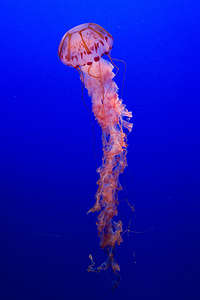 Purple-striped jellyThen there was one all alone in a tank. I think it was a purple-striped jellyfish, known for its painful sting. No wonder no one wanted to play with it. Its tentacles were long and trailed behind it as it moved, creating all kinds of interesting shapes.
Purple-striped jellyThen there was one all alone in a tank. I think it was a purple-striped jellyfish, known for its painful sting. No wonder no one wanted to play with it. Its tentacles were long and trailed behind it as it moved, creating all kinds of interesting shapes.
More compact was the moon jelly, an alien-looking creature named for its translucent, moonlike bell. Instead of long trailing tentacles, it has short ones that sweek food toward the mucous layer on the edge of its bell.
Watching these beautiful, amazing creatures, I forgot for a while that I hated jellyfish and avoided them at all costs.
 Moon JelliesThe last major exhibit we saw was the Open Seas, the main part of the ocean, beyond territorial waters.
Moon JelliesThe last major exhibit we saw was the Open Seas, the main part of the ocean, beyond territorial waters.
Life in the open seas is divided into two groups: drifters (plankton, jellyfish, and octopus) and swimmers (nekton, such as fishes, whales, sea turtles, and squid).
The Open Seas exhibit is a million-gallon tank full of small sharks, bluefin and yellowfin tuna, sunfish, various jellyfish and rays, sea tortoises, Pacific sardines, and much more.
It’s like one big smorgasbord out there and many of its residents must find ways to avoid predators. For example, sardines and anchovies work together by schooling to make themselves look like an intimidating large creature, rather than the little hors d'oeuvres they are. We saw this in real time as we watched a giant sea turtle swim towards them in hopes of a meal.
 Clever anchovies (or sardines) pretending they are one big fishAfter having seen all the exhibits, we decided to take a walk along the waterfront towards Fisherman’s Wharf.
Clever anchovies (or sardines) pretending they are one big fishAfter having seen all the exhibits, we decided to take a walk along the waterfront towards Fisherman’s Wharf.
Our first stop was Steinbeck Plaza, where there is a monument that pays tribute to the many people who played a role in the development of Cannery Row and the growing fishing industry in Monterey Bay.
At the top of the rock is John Steinbeck, who wrote the novel Cannery Row. He is definitely one of my favorite authors. Below him are characters (some real and some fictional) from the novel. Directly below him is Dr. Ed Ricketts, a marine biologist and lifelong friend of Steinbeck’s, who is memorized as the character Doc Ricketts in the novel.
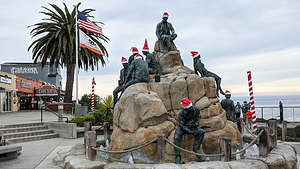 John Steinbeck PlazaThe two women statues are characters from the novel and the four men are the owners of a sardine factory that eventually became the Cannery Row Company.
John Steinbeck PlazaThe two women statues are characters from the novel and the four men are the owners of a sardine factory that eventually became the Cannery Row Company.
The last statue is that of a Chinese fisherman, representing the people who lived in the Chinese fishing village established in the mid 1800’s on the beach surrounding this area.
It was an interesting mix of the real and the fictional. They all looked so festive in their Santa hats.
Next, we walked through Cannery Row, which was a real place, not just the setting for a Steinbeck novel. In the early 20th century, this area was home to 16 canning plants that produced thousands of tons of sardines per year. The fishing industry collapsed in the 1950s, but the area has found a new profitable industry - tourism.
 Herb at Fisherman's WharfBefore proceeding to Fisherman’s wharf, we decided to have lunch at Crepes of Brittany, which we had seen on a YouTube video about Monterey. The owners’ passion is to bring the authentic taste of Brittany-style crepes to Monterey Bay.
Herb at Fisherman's WharfBefore proceeding to Fisherman’s wharf, we decided to have lunch at Crepes of Brittany, which we had seen on a YouTube video about Monterey. The owners’ passion is to bring the authentic taste of Brittany-style crepes to Monterey Bay.
I hadn’t had a crepe in years, so I wouldn’t know a Brittany-style crepe from an ordinary crepe, but in either case, the salmon, brie, and spinach crepe I had was delicious. Herb’s ham and eggs crepe was good as well, but I think I made the better choice.
We couldn’t leave Monterey without the obligatory walk out onto Fisherman’s Wharf, which reminded me a lot of San Francisco’s Fisherman’s Wharf in its touristy kitsch - the kind of place where you never find a local.
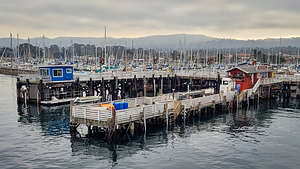 Fisherman's WharfThe day wasn’t over yet. Herb always likes to say that I always try to pack 10 pounds in a 5 pound bag. I think of it as living life to its fullest.
Fisherman's WharfThe day wasn’t over yet. Herb always likes to say that I always try to pack 10 pounds in a 5 pound bag. I think of it as living life to its fullest.
Anyway, before returning to our hotel, we took a drive along 17-Mile Drive, a private toll road through a ritzy neighborhood that includes the famous Pebble Beach golf course and some incredible scenery. At the gate,we paid our $10.75 per vehicle.
It was pretty cloudy and damp, but we pretty much stopped anyway at every one of the marked scenic viewpoints. There was some pretty nice real estate along the way as well.
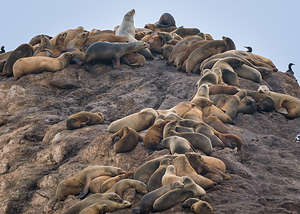 Seal Rock along 17-Mile DriveSeal Rock didn't disappoint. There were dozens of harbor seals, in various shades of white to silver-gray to dark brown, basking on a large rock just off the shoreline. They were so well camouflaged that I hardly noticed them. I guess that's the point. Thank goodness for telephoto lenses.
Seal Rock along 17-Mile DriveSeal Rock didn't disappoint. There were dozens of harbor seals, in various shades of white to silver-gray to dark brown, basking on a large rock just off the shoreline. They were so well camouflaged that I hardly noticed them. I guess that's the point. Thank goodness for telephoto lenses.
The most beautiful stop was Lone Cypress, a Monterey Cypress tree standing atop a granite headland overlooking Carmel Bay - one of the most photographed trees in North America.
It is believed to be about 250 years old, which means it began its life when this area was part of New Spain, grew up as part of Mexico, and finally became part of the United States in 1850.
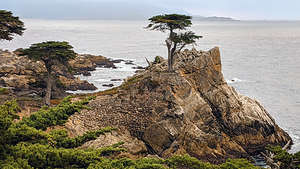 Lone CypressIt was still stunning, but it had taken a bit of a hit since we had been here about 25 years ago. In 2019, the iconic tree lost one of its limbs (accounting for about a third of the tree) during a severe storm known as a Pineapple Express. The before and after photos illustrate just how much its appearance was altered.
Lone CypressIt was still stunning, but it had taken a bit of a hit since we had been here about 25 years ago. In 2019, the iconic tree lost one of its limbs (accounting for about a third of the tree) during a severe storm known as a Pineapple Express. The before and after photos illustrate just how much its appearance was altered.
When we got back to the hotel, we had a glass of wine before our cozy fireplace before going out to dinner at the Treehouse Cafe, another restaurant that we had seen on our YouTube research of Carmel. It was also very highly rated on Yelp and Tripadvisor.
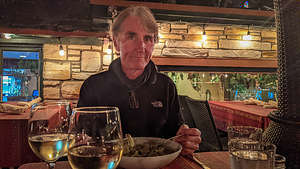 Dinner at the Treehouse CafeThe forecast was for rain later this evening, but so far so good, so we decided to venture out in the hopes of eating on their lovely outdoor patio. So far so good, so we asked to be seated outdoors, where we had the whole patio to ourselves. There are definitely advantages to traveling mid-week.
Dinner at the Treehouse CafeThe forecast was for rain later this evening, but so far so good, so we decided to venture out in the hopes of eating on their lovely outdoor patio. So far so good, so we asked to be seated outdoors, where we had the whole patio to ourselves. There are definitely advantages to traveling mid-week.
The setting was lovely, the heaters were warm (even enough for Herb), and the food was delicious. I had the Prawn Pasta and Herb had the Chicken Alfredo Pasta. We also had a very generous pour of Chardonnay.
Just as we were finishing up, we felt a few drops of rain. Fortunately, it held off and we made it back to our cozy room just in time.
Day 3 - Drive to Big Sur, McWay Waterfall, Nepenthe Restaurant, Pfeiffer Beach, and sunset at Weston Beach (Point Lobos)
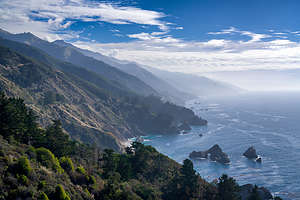 Big SurToday we would head out on a road trip down Big Sur, the rugged stretch of California’s central coast, bordered by the Santa Lucia Mountains and the Pacific Ocean.
Big SurToday we would head out on a road trip down Big Sur, the rugged stretch of California’s central coast, bordered by the Santa Lucia Mountains and the Pacific Ocean.
The non-stop beautiful scenery along narrow, winding Route 1 (also known as the Pacific Coast Highway) is breathtaking, making it hard to keep your eyes on the road. Fortunately, there are dozens of pull-outs to safely enjoy the scenery.
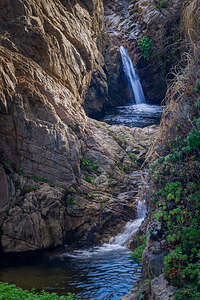 Soberanes Canyon Trail waterfallYou could spend days, if not weeks, exploring this section of the coast, but since we had one day, we had to be selective in our stops. Our plan was to drive as far as McWay Falls, 38 miles south of Carmel, making stops along the way, most of them selected from our trusty “Photographing California (South)” guide.
Soberanes Canyon Trail waterfallYou could spend days, if not weeks, exploring this section of the coast, but since we had one day, we had to be selective in our stops. Our plan was to drive as far as McWay Falls, 38 miles south of Carmel, making stops along the way, most of them selected from our trusty “Photographing California (South)” guide.
Our first stop was in Garrapata State Park, or at least a tiny piece of it. The entire park is nearly 3,000 acres of rocky coastal cliffs, beach, redwood canyons, and part of the Santa Lucia Range, but we just explored a tiny, but very pretty, piece of it along Highway 1 - Soberanes Cove.
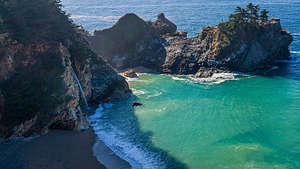 McWay WaterfallsFrom a pull-out along the road, just south of Soberanes Creek. From there, we took a short walk along a path overlooking the rocky outcrops and sea stacks of Soberanes Cove. Eventually, we came to a picturesque wooden bridge over the Creek, with a lovely two-tiered waterfall beneath it.
McWay WaterfallsFrom a pull-out along the road, just south of Soberanes Creek. From there, we took a short walk along a path overlooking the rocky outcrops and sea stacks of Soberanes Cove. Eventually, we came to a picturesque wooden bridge over the Creek, with a lovely two-tiered waterfall beneath it.
Continuing on, we stopped at several more pull-outs, obviously placed for their scenic vantage point above jagged cliffs and rocky beaches.
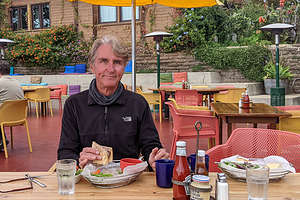 Nepenthe RestaurantThe turnaround point for a drive (we had things planned for the way back) was McWay Falls in Julia Pfeiffer Burns State Park.
Nepenthe RestaurantThe turnaround point for a drive (we had things planned for the way back) was McWay Falls in Julia Pfeiffer Burns State Park.
McWay Falls has the distinction of being one of only two named waterfalls in California that are also tidefalls, meaning that they fall directly into the sea, or in this case, into the lapping aquamarine water of a pristine sandy cove (at least at high tide). It is extremely picturesque, so much so that it is one of the most photographed landmarks in California.
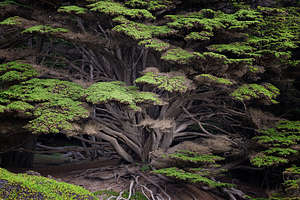 Cypress tree on the path to Pfeiffer BeachWe paid our $10 fee to park our car, and the ranger assured us that our receipt would allow us entry that day into any California State Park. Oh good, we could amortize this when we went to Pfeiffer Beach later today.
Cypress tree on the path to Pfeiffer BeachWe paid our $10 fee to park our car, and the ranger assured us that our receipt would allow us entry that day into any California State Park. Oh good, we could amortize this when we went to Pfeiffer Beach later today.
After parking the car, we took the Overlook Trail which led us through a tunnel beneath Highway 1. From there it was just a short distance along a trail that followed cliffs to an overlook that faced the Falls.
 Pfeiffer BeachAt the end, there was a fence strongly suggesting that we go no further. A rockfall had made the trail unsafe. So what used to be a 0.6-mile walk to a second overlook, was not restricted to a 0.2 one to the first.
Pfeiffer BeachAt the end, there was a fence strongly suggesting that we go no further. A rockfall had made the trail unsafe. So what used to be a 0.6-mile walk to a second overlook, was not restricted to a 0.2 one to the first.
We also learned why that sandy cove was so pristine and free of footprints. There was no public access allowed.
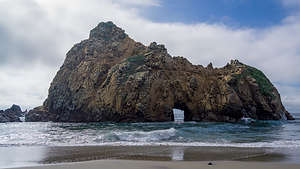 Pfeiffer Beach - Keyhole ArchStill, it was very pretty from the first overlook.
Pfeiffer Beach - Keyhole ArchStill, it was very pretty from the first overlook.
Unfortunately, we were here at high noon, the absolute worst time of the day for photography, when there is no light at all on the falls. We knew that would be the case beforehand though. You can’t be everywhere at sunset, so you can’t see everything at it’s best.
On our drive back up north along the Pacific Highway, we stopped at Nepenthe, an extremely popular and well-known restaurant, perched high above the sea, with a lovely outdoor patio overlooking the Pacific.
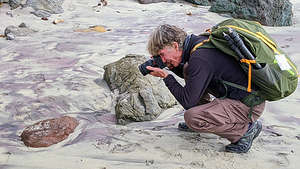 Herb stalking purple sand on Pfeiffer BeahUnfortunately for us, we just had to imagine those views, because a fog had moved in obscuring that beautiful coast below us. Still, it was nice knowing it was there.
Herb stalking purple sand on Pfeiffer BeahUnfortunately for us, we just had to imagine those views, because a fog had moved in obscuring that beautiful coast below us. Still, it was nice knowing it was there.
I found the name interesting, so I looked it up. Nepenthe is a drug described in Homer's Odyssey as banishing grief or trouble from a person's mind. Just like the food, drink, and views here could do - erase your cares, if even only for the duration of a lunch.
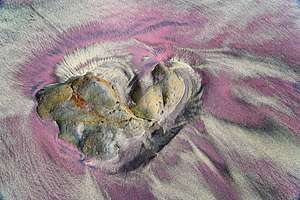 Purple sand of Pfeiffer BeachIn fitting with the Greek theme, I ordered the Ambrosiaburger, remembering that in Greek mythology, ambrosia was the food of the gods, conferring longevity or immortality on all that consumed it.
Purple sand of Pfeiffer BeachIn fitting with the Greek theme, I ordered the Ambrosiaburger, remembering that in Greek mythology, ambrosia was the food of the gods, conferring longevity or immortality on all that consumed it.
Herb had the more mundane and mortal French Dip. I gave him a few bites of my Ambrosiaburger to keep him around a bit longer.
I was very much looking forward to our next stop, which came highly recommended in our “Photographing California” guide - Pfeiffer Beach.
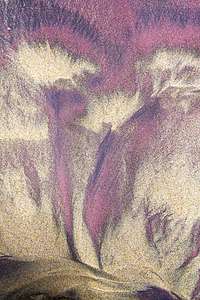 Images in the purple sand - Pfeiffer BeachTo get there, we turned onto Sycamore Canyon Road, which twisted its way for 2 miles down to a ranger station and parking lot. We showed the ranger our California State Park receipt, and he informed us that this section of the coast was not part of the state park system, but rather it was part of the Los Padres National Forest. $12 please. Oh well, so much for amortizing.
Images in the purple sand - Pfeiffer BeachTo get there, we turned onto Sycamore Canyon Road, which twisted its way for 2 miles down to a ranger station and parking lot. We showed the ranger our California State Park receipt, and he informed us that this section of the coast was not part of the state park system, but rather it was part of the Los Padres National Forest. $12 please. Oh well, so much for amortizing.
There are two rather unique natural phenomena that occur on Pfeiffer Beach:.
Phenomenon 1: For a few days surrounding the winter solstice, the sunset is lined up with the opening in Keyhole Arch, an opening on a sea stack just a short distance from the shore. This is the big event of the year here and literally brings hundreds of photographers who line up elbow to elbow to catch the nearly identical shot to the guy next to him. This is Herb’s nightmare. He likes solitude and creating his own compositions. Fortunately, we were here too early in December for this event anyway.
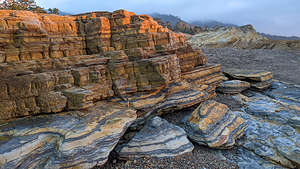 Sunset Weston Beach - Point LobosPhenomenon 2: Purple sand. That’s right, purple sand, especially right after a rain, which as luck would have it was now.
Sunset Weston Beach - Point LobosPhenomenon 2: Purple sand. That’s right, purple sand, especially right after a rain, which as luck would have it was now.
As we strolled along the beach, I kept my eyes peeled to the ground in search of purple sand. There was some darker sand that I thought might be it, but I wasn’t particularly impressed. As we continued further down the beach, we finally came across it, and it was amazing! Much brighter and more distinctive than I imagined it would be.
Every time we came across some patches, I noticed that there was a fairly steep hill above them, with some sprinkles of purple mixed in. I later read that these are manganese garnet deposits, and they wash down onto the beach after a rain.
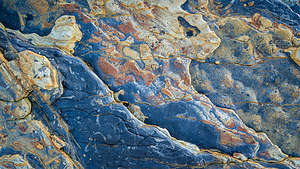 The rocks come alive on Weston Beach at sunsetWe found these patterns extremely intriguing and could have spent our entire time on the beach just photographing them.
The rocks come alive on Weston Beach at sunsetWe found these patterns extremely intriguing and could have spent our entire time on the beach just photographing them.
Originally, I had thought we might stay here to watch the sunset, but that would require us driving back up narrow, winding Route 1 in the dark. Instead we decided to go back to Weston Beach in Point Lobos, which was much closer to home.
We had spent sunset at Weston Beach on our first night in Carmel and had enjoyed watching the sunset. There was no purple sand on this beach. In fact, there was no sand at all, but rather just very interesting textured rocks and tide pools in between.
 Sunset Weston Beach - Point LobosI think you could spend hours here always discovering something new. This time I found some rocks that actually lit up with blue and orange layers during golden hour. So, we spent the last minutes of daylight scampering over the rocks looking for interesting compositions.
Sunset Weston Beach - Point LobosI think you could spend hours here always discovering something new. This time I found some rocks that actually lit up with blue and orange layers during golden hour. So, we spent the last minutes of daylight scampering over the rocks looking for interesting compositions.
It had been a very full day, and we had had a big lunch, so I just wanted to get something light for dinner. I pushed for the Hog’s Breath Inn, Carmel’s most famous establishment because it used to be owned by Clint Eastwood. Herb objected at first, because he felt that it was more of a tourist trap than a fine dining experience. Still, I knew the setting was nice, and everyone was going to ask me if I went to the Hog’s Breath Inn while in Carmel.
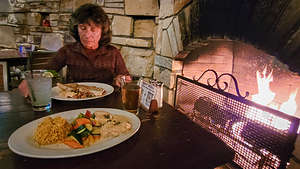 Dinner at the Hog's Breath InnThere were very few people there, as it was a weeknight in the week after Thanksgiving, so we were able to get a great table next to one of their fireplaces.
Dinner at the Hog's Breath InnThere were very few people there, as it was a weeknight in the week after Thanksgiving, so we were able to get a great table next to one of their fireplaces.
I just had a quesadilla with chicken, which was very good, and Herb had an “okay” chicken piccata. I got a fancy margarita thinking Herb was getting one too, but he ordered a beer, making me feel a bit decadent.
Still, the experience was very nice and I was happy.
Then it was back to our room and our last night in our beach chairs before our cozy fireplace at the Carmel Bay View Inn.
Day 4 - Morning walk around Carmel (Carmel Beach and Carmel Mission) and drive home
 Herb strolling along Carmel BeachTime to go home, but I realized that we hadn’t really explored Carmel itself that much. That just wasn’t right, so we set off on foot to see this charming seaside town.
Herb strolling along Carmel BeachTime to go home, but I realized that we hadn’t really explored Carmel itself that much. That just wasn’t right, so we set off on foot to see this charming seaside town.
We left the car at the hotel and set off down Ocean Avenue, past the many quaint homes ranging from Spanish colonial homes to Tudor-like cottages to fairy-tale gingerbread houses with stone chimneys and pitched roofs.
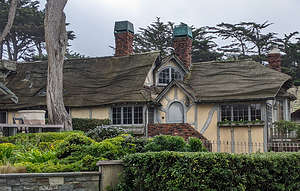 Fairy-tale gingerbread houses with stone chimneys and wavy pitched roofs.In less than a mile we arrived at Carmel Beach and the 3.5-mile Scenic Bluff Path that runs along scenic drive, starting at Carmel Beach’s northern end and winding along the ocean around Carmel Point all the way to Carmel River State Beach.
Fairy-tale gingerbread houses with stone chimneys and wavy pitched roofs.In less than a mile we arrived at Carmel Beach and the 3.5-mile Scenic Bluff Path that runs along scenic drive, starting at Carmel Beach’s northern end and winding along the ocean around Carmel Point all the way to Carmel River State Beach.
We walked along the sand for a while before realizing that the houses along Scenic Drive were the real points of interest, including one near Carmel Point that was designed by Frank Lloyd Wright in the 1950s.
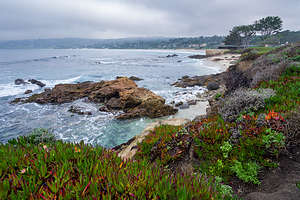 Along Carmel's Scenic Bluff PathAfter rounding Carmel Point, we headed inland past the Tor House, the historic house and tower built of sea-tossed granite of the famous poet Robinson Jeffers, known for his work about the central California coast as well as being an icon of the environmental movement. Unfortunately, it is only open to the public on weekends, so we could only look at it from outside the gate.
Along Carmel's Scenic Bluff PathAfter rounding Carmel Point, we headed inland past the Tor House, the historic house and tower built of sea-tossed granite of the famous poet Robinson Jeffers, known for his work about the central California coast as well as being an icon of the environmental movement. Unfortunately, it is only open to the public on weekends, so we could only look at it from outside the gate.
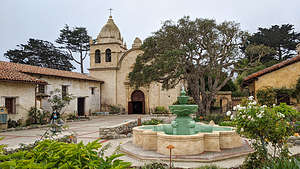 Carmel MissionWe continued walking away from the beach up 15th Street and Deloros towards the Carmel Mission, passing Clint Eastwood’s Mission Ranch Hotel and Restaurant, which he bought and rescued from condo developers, along the way.
Carmel MissionWe continued walking away from the beach up 15th Street and Deloros towards the Carmel Mission, passing Clint Eastwood’s Mission Ranch Hotel and Restaurant, which he bought and rescued from condo developers, along the way.
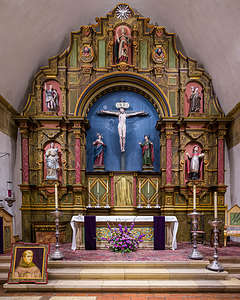 Carmel Mission Altar with portrait of Juniper SerraI never know quite what to feel when visiting one of the Spanish missions - and we have been to many. I love their serenity and aesthetic beauty, but have a problem with their treatment of the Native American population. However, I am a history buff, warts and all, and feel that it is important to be aware of our past and to learn from it.
Carmel Mission Altar with portrait of Juniper SerraI never know quite what to feel when visiting one of the Spanish missions - and we have been to many. I love their serenity and aesthetic beauty, but have a problem with their treatment of the Native American population. However, I am a history buff, warts and all, and feel that it is important to be aware of our past and to learn from it.
The Carmel Mission is the second of the Alta (Upper) California Spanish missions. It was originally established in Monterey in 1770 by the Spanish priest Junipero Serra, but was moved the following year to Carmel, near the mouth of the Carmel River, because of lack of good agricultural land.
Serra went on to create seven more missions before he died in 1784. He is interred in the Carmel Mission chapel.
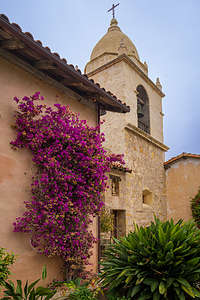 Carmel Mission GardenIn 2015, Juniper Serra was canonized and made a Saint. There was much controversy over this as critics questioned the Spanish missions’ sometimes brutal treatment of the Native Americans, their mandatory conversion to Catholicism, and denial of allowing them to keep their traditional culture and beliefs. It’s always difficult judging past actions in terms of current standards.
Carmel Mission GardenIn 2015, Juniper Serra was canonized and made a Saint. There was much controversy over this as critics questioned the Spanish missions’ sometimes brutal treatment of the Native Americans, their mandatory conversion to Catholicism, and denial of allowing them to keep their traditional culture and beliefs. It’s always difficult judging past actions in terms of current standards.
There did seem to be an attempt at reconciliation with their past “less-than-benevolent” treatment of the Native Americans. A section of the Mission’s cemetery is dedicated to unnamed graves marked by abalone shells, representing the hundreds of indigenous people who died at and near the Mission.
A sign reads:
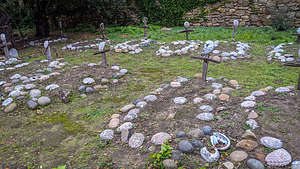 Unnamed graves marked by abalone shells, representing the indigenous people who died here“These symbolic grave sites, adorned with abalone shells, represent the many hundreds of indigenous people buried in the graveyard and beyond. May they be honored, and may we be reminded of their long term presence, their rich culture and humanity, and the importance that they still hold for their descendants today.”
Unnamed graves marked by abalone shells, representing the indigenous people who died here“These symbolic grave sites, adorned with abalone shells, represent the many hundreds of indigenous people buried in the graveyard and beyond. May they be honored, and may we be reminded of their long term presence, their rich culture and humanity, and the importance that they still hold for their descendants today.”
Wow! A little late, but better than never at all. Or, as Martin Luther King, Jr., once said, “the arc of the moral universe is long, but it bends toward justice.”
In our mini 3-day vacation, we had seen a lot - incredible natural beauty, lovely sunsets, a bit of Cannery Row and Spanish Mission history, much animal life from butterflies to jellyfish to sharks and more, and last, but not least, some great food and wine.
- 1 of 1
Carmel and Side Trips location map in "high definition"
Javascript is required to view this map.
